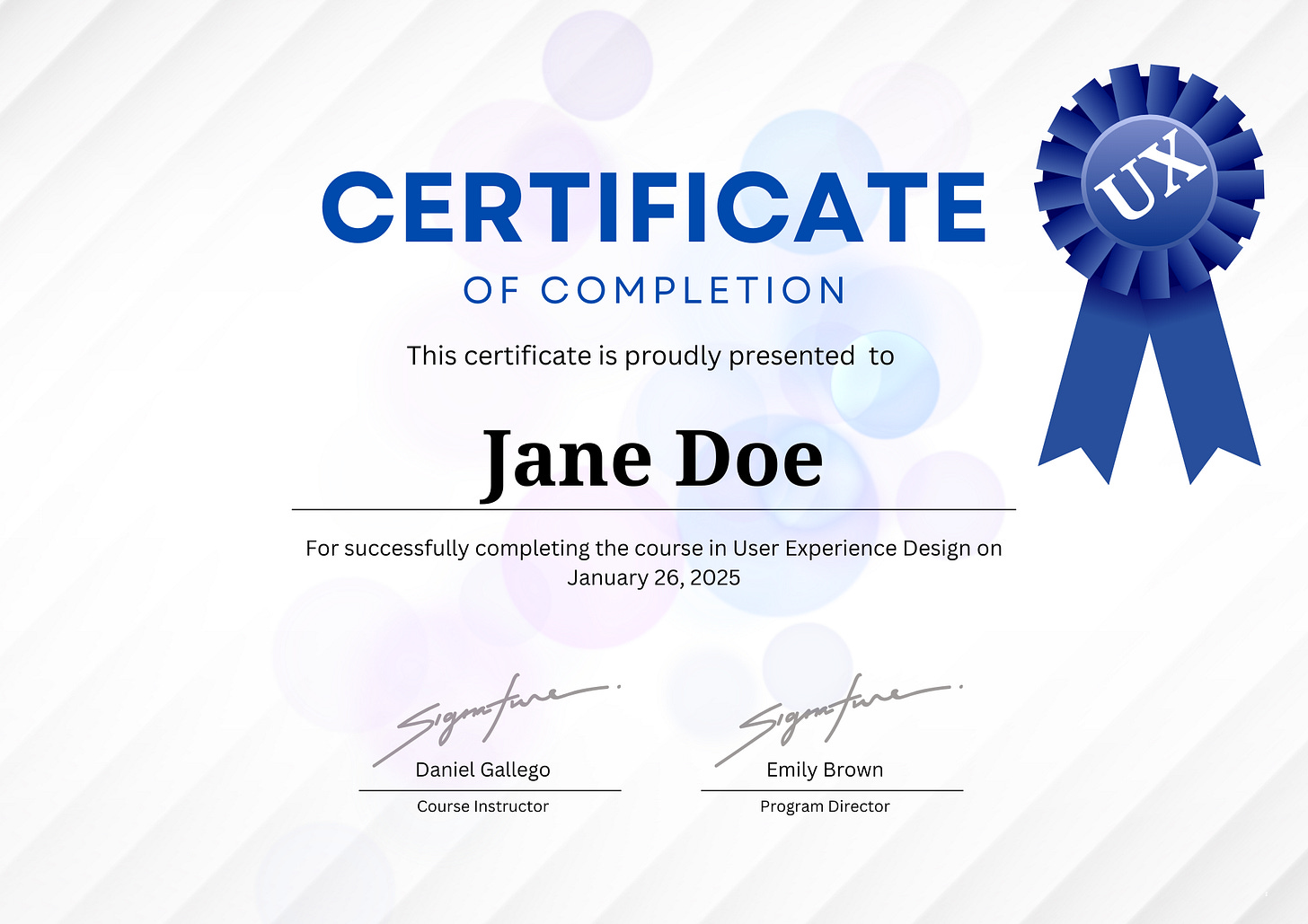UX Certifications: Do You Really Need One to Succeed?
Do UX Certifications Really Matter?
You’ve seen the ads: “Get certified in UX design and land your dream job!” But are certifications really the key to success, or just a shiny badge with little payoff?
The UX industry is buzzing about certifications, but the truth isn’t so black and white. While some certifications can open doors, others won’t outweigh a strong portfolio or hands-on experience. So how do you decide if investing in one is worth it?
Today, we’ll break down the facts, the myths, and how to make an informed decision that aligns with your career goals.
Key Insight: The Real Value of UX Certifications
Certifications: What they do—and what they don’t
Why some employers value them and others don’t
When investing in a certification is worth it
Limitations to Consider
How to Decide If You Really Need One
Practical Tips: How to Choose the Right Certification
Community Spotlight: “Do Certifications Actually Work? Share Your Story!”
UX Workshop: Choosing The Right UX Career Path
Resource Corner: Tools, Reads, and Certification Platforms
Tool of the Week: Coursera – Affordable UX Certification Programs
Key Insight: The Real Value of UX Certifications
Certifications can help—but they’re not the golden ticket many think they are. Understanding when and why to pursue one is crucial.
Certifications: What They Do—and What They Don’t
Here’s the honest truth:
What They Do:
Demonstrate your commitment to learning and self-improvement.
Provide structured education, especially for beginners.
Help bridge knowledge gaps in specific areas (e.g., accessibility, UX writing).
What They Don’t:
Guarantee a job.
Replace a strong portfolio or hands-on experience.
Automatically make you more qualified than non-certified professionals.
Why Some Employers Value Them—and Others Don’t
A 2024 MeasuringU survey found that certification did not appear to generate higher pay. In fact, the median pay for those with certification was nominally (but not significantly) lower than respondents without certification. (Source)
Here’s why:
Employers prioritize problem-solving skills and portfolio quality over credentials.
Certifications are often seen as a signal of commitment, but not proof of real-world ability.
Some roles—particularly entry-level ones—may favor certifications as a way to gauge foundational knowledge.
When Investing in a Certification Is Worth It
Consider a certification if:
You’re new to UX: Certifications can help you establish credibility when transitioning from another field.
You want to specialize: Programs in accessibility, service design, or UX writing can set you apart in niche areas.
You need a confidence boost: A structured program can help fill gaps in your knowledge and make you feel more prepared.
Limitations to Consider:
Cost: Some certifications can be expensive. For instance, the Google UX Design Certificate costs $49 per month on Coursera. (source)
No Job Guarantees: Holding a certification doesn't automatically secure employment; practical experience and a strong portfolio remain crucial. (Source)
Variable Quality: The depth and quality of certification programs can vary, so it's essential to research and choose reputable courses.
How to Decide If You Really Need One
Before enrolling in a program, ask yourself these questions:
What’s My Goal?
Are you trying to break into UX, advance in your current role, or specialize in a niche?
If you’re entering the field or pivoting from another career, a certification can signal your credibility.
What’s My Experience Level?
If you already have a strong portfolio, certifications may not add significant value.
If you’re starting from scratch, certifications can provide structure and clarity.
Do Employers in My Desired Role Value Certifications?
Research job postings to see how often certifications are listed as requirements or preferences.
Can I Afford It?
Programs range from $39/month to thousands of dollars. Consider whether the ROI is worth the cost.
Am I Willing to Put in the Effort?
Certifications are only valuable if you actively engage with the material. Make sure you’re ready to commit the time and energy.
Tips: How to Choose the Right Certification
Define Your Goal: Are you trying to break into UX, specialize, or simply learn a new skill? Pick a certification that aligns with your purpose.
Research Industry Recognition: Look for programs like Nielsen Norman Group or Interaction Design Foundation (IDF), which are widely known respected.
Check for Portfolio Opportunities: Programs that include portfolio projects (e.g., Career Foundry) can add real value to your resume.
Consider Cost and Time: Evaluate the return on investment—don’t overspend on a program that won’t directly impact your career.
Upcoming Workshop
If you are struggling to figure out what your next step is in your career, this workshop could be the key:
Join our 90-minute webinar to uncover your unique strengths, align your goals, and find a UX career path that truly excites you.
Resource Corner: Tools, Reads, and Certification Platforms
Tool: Udemy– Affordable certification programs, including Google’s UX Design Certificate.
Book: Think Like a UX Researcher by David Travis and Philip Hodgson.
Article: Is UX certification helpful for getting a job? by Chris Nodder
Explore this collection of FREE and Paid courses in UX
Tool of the Week: Coursera – Affordable UX Certification Programs
Here’s how Coursera supports your learning goals:
Affordable courses starting at $39/month.
Industry-recognized programs like Google UX Design.
Flexible learning, allowing you to progress at your own pace.
Final Note | Certifications Are One Tool, Not the Only Tool
Certifications can complement your skills, but they’re not a substitute for hands-on experience or a standout portfolio. Use them strategically to boost your confidence, fill knowledge gaps, or break into UX.
At the end of the day, your work speaks louder than any certificate. Let’s focus on building a career that truly showcases your impact.






